
Praetorium, Roman garrison commander\'s property, has been discovered by found Polish archaeologists working in the Crimea, told PAP Dr. Radosław Karasiewicz-Szczypiorski of the Institute of Archaeology, University of Warsaw, head of excavations in Balaklava, Ukraine.
Until now, researchers have speculated that this house was located at the citadel in nearby Chersonesus.
Archaeologists studied the building of unknown purpose in previous seasons. This year\'s work allowed for its full exploration.
"At first we thought that we were digging up the common barracks or quarters of one of the officers - centurions. However, the structure turned out to be more extensive than we thought. We uncovered a large house with rooms surrounding a stone-paved courtyard from three sides. Analogies with similar Roman forts indicate that the house belonged to the garrison commander" - said Dr. Karasiewicz-Szczypiorski.
The commander of the garrison was a high-ranking officer (tribune), who probably only visited outposts, and had permanent quarters on the Lower Danube.
Best preserved was the last construction phase of the building, dating back to the turn of the second and third century and the first decades of the third century.
"Discovery of the praetorium in Balaklava suggests that, at least in the beginning of the third century, the quarters of the Roman army commander in Tauris (the ancient name of Crimea - ed. PAP) was the fort in Balaklava, and not, as previously thought in the nearby Chersonesus citadel" - said Dr. Karasiewicz-Szczypiorski .
Warsaw archaeologists first visited Balaklava in the 1990s. The excavations are carried out jointly with the staff of the local museum " Chersonesus Taurica" in Sevastopol. The result of these studies include the discovery of the temple of Jupiter Dolichenus. The current project was carried out for three seasons with the funds from the Ministry of Science and Higher Education.
PAP - Science and Scholarship in Poland, Szymon Zdziebłowski
szz/ agt/ mrt/
tr. RL













